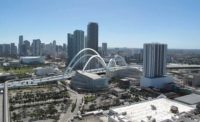Best Value Selection
The Numbers Behind the Archer Western-Fluor Bridge Clash
How a committee change registered in scoring for a new Miami bridge

A Fluor-led team's design proposal for a new bridge in Miami had garnered higher aesthetic scores, but the state ultimately chose a competing design by Archer Western-de Moya Group.
PHOTO COURTESY FDOT
Behind a bitter legal battle that has stalled plans for an $800-million “signature” bridge project on the Miami skyline, there are two dramatically different interpretations of just how the winning team was to be selected.
The Florida Dept. of Transportation in May sparked an uproar when it chose a joint venture of Archer Western and local contractor de Moya Group over a Fluor-led team for the showcase project to replace a low-slung, 1960s-era expressway that cuts through downtown Miami’s historically black Overtown neighborhood.
 Archer Western came out on top in the best-value scoring system used by the state, despite the fact that Fluor had won higher grades on the key aesthetic portion of the review. A critical disagreement is whether FDOT had too much voting power on the aesthetics committee. Former Miami Commissioner Marc Sarnoff’s 2013 lawsuit produced not only a settlement that outlined the aesthetics committee’s role and membership but also many project documents. Sarnoff sued on behalf of Miami residents who demanded a “signature” bridge of outstanding design. In reopening the lawsuit, Sarnoff says FDOT circumvented the intent of the 2013 court settlement by stacking the aesthetics review committee for a crucial April scoring session in which five FDOT staffers replaced a lone prior FDOT committee member.
Archer Western came out on top in the best-value scoring system used by the state, despite the fact that Fluor had won higher grades on the key aesthetic portion of the review. A critical disagreement is whether FDOT had too much voting power on the aesthetics committee. Former Miami Commissioner Marc Sarnoff’s 2013 lawsuit produced not only a settlement that outlined the aesthetics committee’s role and membership but also many project documents. Sarnoff sued on behalf of Miami residents who demanded a “signature” bridge of outstanding design. In reopening the lawsuit, Sarnoff says FDOT circumvented the intent of the 2013 court settlement by stacking the aesthetics review committee for a crucial April scoring session in which five FDOT staffers replaced a lone prior FDOT committee member.
The Fluor proposal still won the aesthetics component of the review, but the vote was much closer than it should have been, Sarnoff contends. In the overall scoring out of a possible 100, the five new FDOT voters helped Archer Western’s team reach 88.36 points, compared to the Fluor team’s 87.8, for a narrow 0.53-point victory. The Fluor team has filed a separate, formal bid protest.
The 2013 settlement required aesthetics to play a key role in the selection. Up to 60 points were at stake in the technical review and up to 30 for aesthetics, with the remaining 10 for schedule and price.
But FDOT, which has yet to respond to Sarnoff’s new complaint in Miami-Dade County circuit court, is likely to argue there was no violation or bending of the best-value selection process.
On Feb. 6, FDOT requested a design-build-finance proposal. It laid out a four-step process: short-listing, pass-fail review by the aesthetics committee, scoring the technical and aesthetic submissions, and the price and financial proposal submission.
Sarnoff contends that the third step should have consisted of a vote by the aesthetics committee on the design of the bridge proposals and a separate vote by the engineer-dominated panel on the technical merits of the proposals.
However, the RFP did not spell out in detail how the voting was supposed to happen in that third step. For example, the RFP never said the aesthetics panel had exclusive control over the aesthetics scoring or that the two panels would vote separately. To the contrary, while the aesthetics panel was given the job of scoring the “aesthetic volume of the technical proposal,” the technical panel was given the same job, in addition to scoring the proposals’ technical merits. In fact, the wording—scoring the “aesthetic volume of the technical proposal”—is the same for the aesthetic and technical committees.
The scoring criteria “was set more than one year ago and was not changed,” wrote A.L. de Moya, vice president and general manager of the contractor that teamed with Archer Western. “Allegations of rigged and skewed scoring are baseless.”
Sarnoff’s case rests on the 2013 court settlement with FDOT, which brought to an end a legal challenge of a previous, less-inspired bridge proposal that had been panned by city officials and neighborhood residents. The agreement promised a fresh start, laying out an unusual system for selecting a design in which aesthetics would play a big role.
In his complaint, Sarnoff points to the provisions of that earlier settlement agreement, which called for a five-person aesthetics committee comprising four community representatives and one from FDOT. They were to have sole control over the evaluation and scoring of the aesthetics portion of the review process, according to the complaint. FDOT officials reiterated that pledge at a series of meetings in 2014 and 2015, during which the aesthetics committee’s role in the review process was fleshed out. Meeting minutes of the committee seem to support that view. But when the FDOT member dropped out before the crucial April scoring session, FDOT designated its technical committee as the voters on the aesthetic committee, Sarnoff claims. With five votes, FDOT comprised a committee majority.
Sarnoff’s lawsuit calls it a matter of bait-and-switch. It should not take many weeks for a state court judge to form its own opinion.




